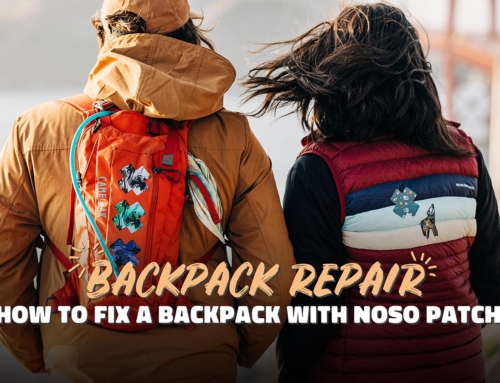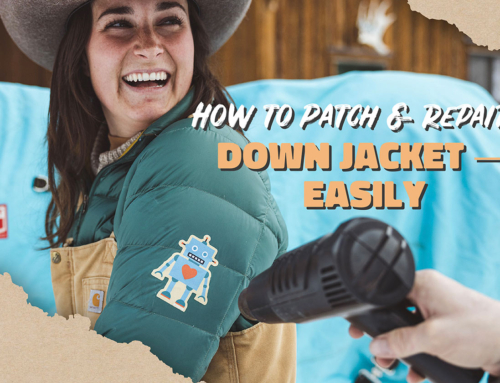If you’re an outdoorsy person, you love being among the elements. The sun on your skin, the wind sweeping your hair, the smell of earth, the sound of rustling trees and animals. It’s all so lovely. But that doesn’t mean you’re immune to the elements. There’s a reason you wear hiking boots, sunglasses, sunscreen, and all the rest. Not to mention your trusty tent to keep you cozy and dry at night.
But what happens when you notice a rip in your tent? Oh no! Whether you’re in for a long backpacking trip or a single night in your tent, nothing puts a damper on the journey more than a tear in your tent. A draft of cold air, rain seeping in, bugs flying all around–yuck!
Luckily, there’s a solution. Here’s the easiest way to repair a tear in your tent.

Easiest Way to Repair a Camping Tent: Tears, Rips, Punctures
When it comes to tent repair, you basically have three options: Glue, duct tape, and NoSo Patches. The first option is all too messy and takes forever to dry. The second option offers a quick fix, but it’s an ugly way to patch up a pretty tent. The last option offers the best protection, is simple as possible, and looks amazing!
Here’s the easiest way to repair your camping tent tear with NoSo Patches:
-
- Trim loose fibers and get rid of any obstructions. Basically, you just want a smooth surface to work with.
- Clean the area of rip inside and out. Alcohol wipes work best. If you don’t have those on hand, just do your best to clean the area so the adhesive can stick.
- Apply NoSo Patch to the outside of the tear. Peel your NoSo Patch, like you would any sticker. Apply it to the torn area. Smooth it out from the center to the edges. If you want to apply another NoSo Patch on the inside, that’s cool too. If the hole is really big, you’ll want to use the “patch sandwich” method—sticking patches on the inside and outside—so the adhesive isn’t showing.
- When you have a chance, apply heat. A hairdryer works best. But if you’re out in the elements, you might not have this on hand. Direct sunlight on a hot day can do the trick. Or you can simply stick your patch and wait until you get home to perform this last step.
- And there you have it! NoSo Patches are permanent, durable, waterproof solutions to your tent problems. Plus, they look nice and give a little personal flair to your tent.
NoSo Patches are so much easier to apply than messy glues that can take 12 or even 24 hours to dry! Not to mention that our patches are much prettier than heavy duct tape.
So pack up some NoSo Patches for your next overnight hike. Not only do they work for tents, but they are also great for puffy jackets, raincoats, backpacks—really any synthetic fabric. You’ll never have to worry again about tears or rips in your favorite outdoor gear or apparel!
How to Repair a Broken Camping Tent Pole
A gentle breeze delights every camper. But harsh gusts that snap your tent poles, not so much. Wobble, flap, collapse—that’s no way to spend the night.
As a tent camper, you have a couple of options to repair your tent pole:
- Splint and sleeve the broken tent pole
- Assess if your tent pole is broken or just bent.
- If it’s bent, straighten it out. If it’s snapped, line up the pieces.
- Center something firm against the affected area—a tent stake is perfect, but whatever you have on hand.
- Take duct tape, bungee cords, a patchdazzle, or something similar and wrap it around the stint and broken pole—make sure it’s tight.
- There you have it!
- Use tension to prop up your tent
- If all else fails, bungee cords or rope can pull against the weakened side by drawing the cord to something stable, like a tree or pole.
For best results combine these two tactics. Add a stent to the broken or bent pole. Wrap the sleeve around that. And prop up the fallen side with a cord. It’ll give you a sturdier fix, even if it’s a little tougher to disassemble when you’re done.
Repairing your outdoor gear is so much better than giving up and throwing your gear away. It’s better for the environment, better for your wallet, and boosts your outdoor skills. And who doesn’t love that?
Want even more helpful tips? Explore the NoSo blog!








